- A Quick Glance at Data Warehousing in Healthcare
- Healthcare Data Warehouse Architecture
- 1. Data source layer
- 2. Staging layer
- 3. Data storage layer
- 4. Analytics and reporting layer
- 1. Enterprise data warehouse model
- 2. Independent data mart models
- Top Use Cases of Healthcare Data Warehousing
- Advanced diabetes management
- Assistance with child immunization
- Enhanced research opportunities
- Providing improved treatment to patients
- Tracking and prevention of tobacco use
- Exploring the Benefits of Data Warehousing in Healthcare
- Key Features to Locate When Implementing a Healthcare Data Warehouse
- Electronic Data Interchange (EDI)
- Data integration
- Data interoperability
- Data storage scalability
- Data Security
- Data backup
- A Brief Glance Into Data Warehousing Implementation
- Evaluation of Current Infrastructure and Data Requirements
- Establishment of Clear Goals and Organizational Objectives
- Selection of an Ideal Data Warehouse Model
- Adoption of an Ideal Tech Stack
- Integration of Standardized Data Sources
- Analysis of System Integrity
- Deployment of the System
- Continuous Assessment to Maintain Quality
- Healthcare Data Warehousing: Best Practices
- Challenges Tackled by Healthcare Data Warehousing
- Challenge 1: Personalized patient care
- Challenge 2: Cost management and operational efficiency
- Challenge 3: Patient experience and satisfaction
- Revolutionize Data-driven Patient Care with Appinventiv’s Healthcare IT Services
- FAQs
The healthcare industry is one of the sectors that generates a massive amount of data, accounting for approximately 30% of the world’s data volume. This value is set to increase, indicating the urgency of healthcare data warehousing.
Data warehousing is an important component of enterprise data management strategy. It is a necessary analytical tool used to make impactful, data-driven decisions. According to a report by MarketResearchFuture, the data warehouse service market industry is projected to reach from $2.68 billion in 2023 to $8.79 billion in 2030.
Data warehousing in healthcare helps centralize various data sources into one main system. This setup allows healthcare providers to better understand and manage patient information, leading to improved care and treatment. As the amount of healthcare data grows, the importance of using data warehousing to handle this data efficiently becomes more crucial.
This article will help you understand the critical role data warehousing plays in transforming healthcare. In addition to exploring the benefits and use cases of data warehousing in healthcare, you will also witness how it not only supports current healthcare needs but also paves the way for future innovations.
A Quick Glance at Data Warehousing in Healthcare
A healthcare data warehouse is a centralized repository designed to store and manage large amounts of health-related data collected from numerous sources. It is a crucial component of an effective healthcare data management strategy. It can help reduce medical errors, promote medical safety, and provide a better all-round healthcare experience for patients. Organizations can leverage its analytical abilities to derive valuable business insights and facilitate improved decision-making.
[Also Read: Data lakes: Next-generation data management solutions for your business]
Also, a healthcare data warehouse can help optimize staff management and procurement and reduce operational costs. This enables process streamlining and allows tracking of performance metrics.
Healthcare Data Warehouse Architecture
Before you develop a data warehouse for healthcare, it is essential to understand the fundamental layers. Here is a representation of the healthcare data warehouse architecture:
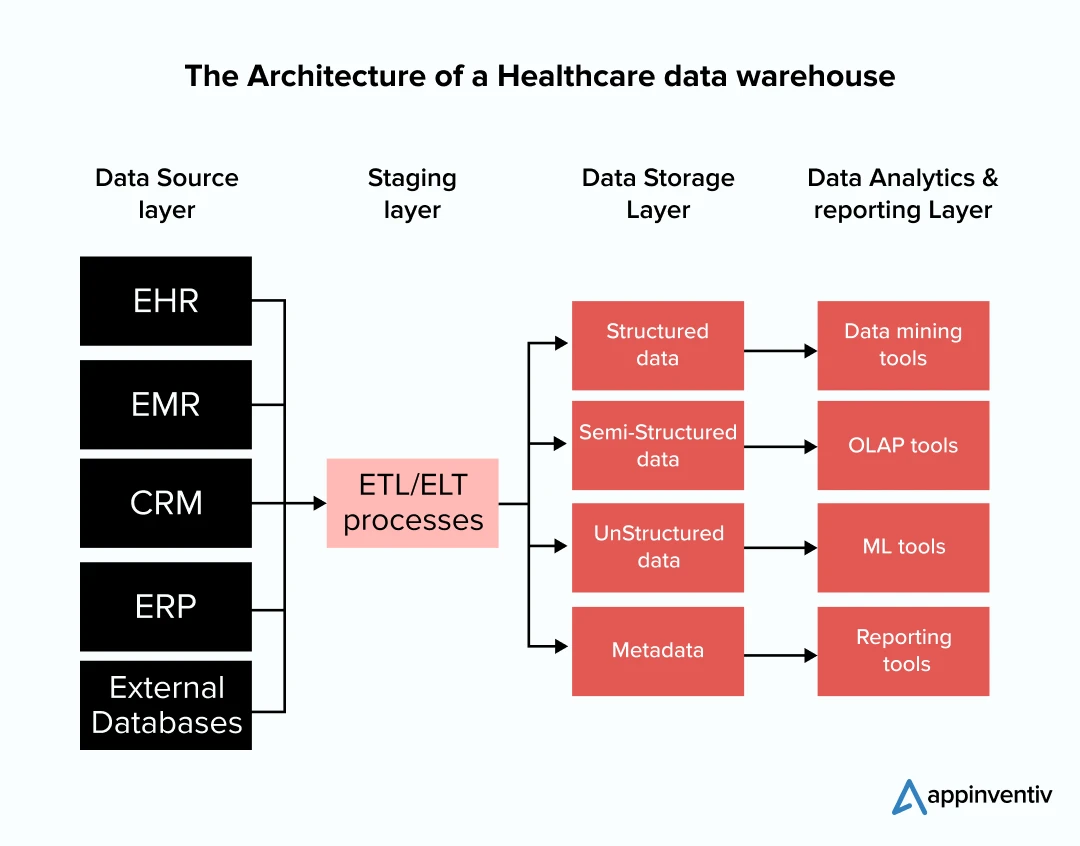
Data warehouse architecture for healthcare has the following layers:
1. Data source layer
It consists of internal and external data sources, collecting relevant medical data. Various kinds of healthcare data are generated from ERP (enterprise resource planning) systems, radiology reports, EHR (electronic health record) reports, prescriptions, CRM (customer relationship management) systems, etc.
2. Staging layer
It is the temporary intermediary storage layer that processes incoming data from diverse sources. All this data undergoes the ELT (extract, load, transform) process, where it is cleansed and transformed from its raw form into consistent data sets.
3. Data storage layer
This centralized storage layer is used for reporting and analyzing structured data. This unified repository is loaded through the ELT process. It also carries data marts – subsets of data warehousing designed for specific business areas like finance, human resources (HR) and technology.
4. Analytics and reporting layer
The final layer of the architecture includes data analytics and business intelligence (BI) in healthcare tools, which are used to draw actionable insights from data. BI tools are leveraged to analyze healthcare data. The insights are shared in the form of detailed reports, graphs, visualizations, charts, and summaries.
Several commonly used healthcare data warehouse models also exist, each carrying its unique strengths and restrictions. Choosing the data model that works best for your organization can help fabricate an effective binding and analysis.
Here are the most popular healthcare data warehouse models:
1. Enterprise data warehouse model
Enterprise data warehouse in healthcare is one of the most comprehensive options. It is a go-to option for large health center networks. The model advocates a top-down approach used by organizations that need additional analytical capabilities.
This model aims to create a perfect database from the very beginning. The enterprise data warehouse model starts by determining everything your organization would want to analyze to improve targeted outcomes. For instance, if your priority is employee safety and quality care for your patients, you will structure the data warehouse accordingly.
However, a significant drawback of leveraging enterprise data warehouses in healthcare is that this model has an early-binding approach. This means that once the data is bound, making any modification can be difficult and time consuming.
2. Independent data mart models
A data mart is an isolated data repository dedicated to one subject. This model uses a bottom-up approach and is generally used for ad hoc analysis. It creates individual data marts for every department.
In other words, this approach is used to work with specialized data subsets from various domains. For instance, you can analyze specific data about a particular type of chronic illness with this model.
The independent data mart model is inherently compact and more focused. Your team can implement and measure needed metrics much quicker using this approach. This is ideal for smaller healthcare providers who want to start improving on specific operations at first.
However, a disadvantage of this approach is that data marts can overwhelm systems easily because of data redundancy.
Top Use Cases of Healthcare Data Warehousing
The data warehouse healthcare industry has revolutionized the storage and analysis of medical information. There are several practical applications of it. Here are a few healthcare data warehousing use cases to introduce you to several of its implementations.
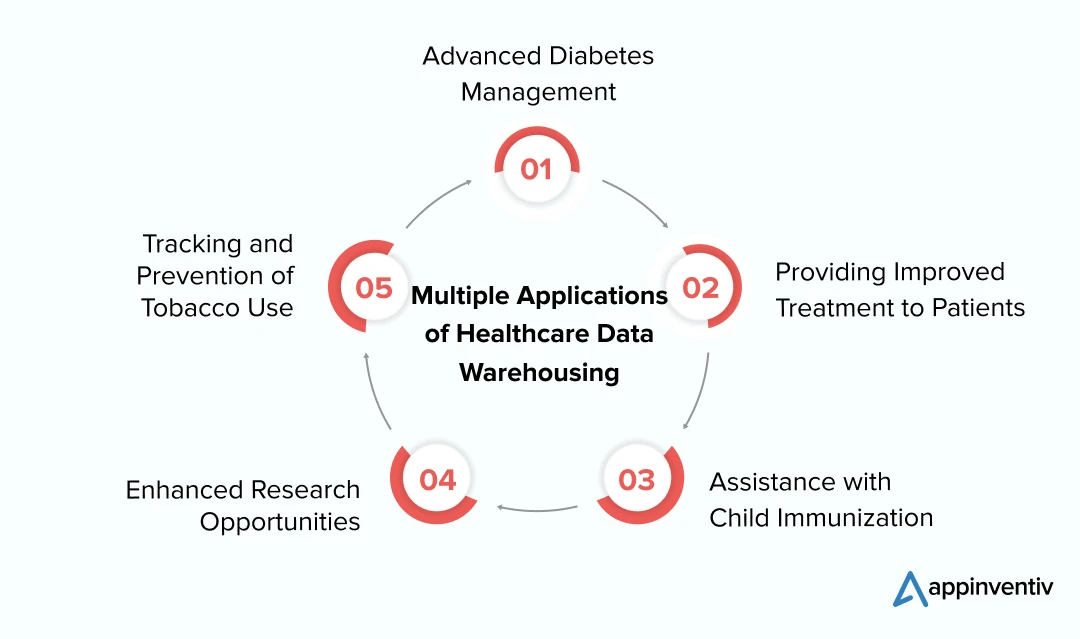
Advanced diabetes management
Diabetes is a disease that affects around 38 million adults in the United States alone. It has been listed as the eighth leading cause of death. Monitoring this disease is especially important because if left untreated, it can cause several other serious conditions, such as blindness, kidney problems and stroke.
This is one of the popular data warehouse healthcare examples where analyzing tools can be leveraged to monitor and treat diabetes patients. It provides insights that can be used to identify trends, risk factors, and patterns. It also supports disease management initiatives like glucose level checks and medication provided.
[Also Read: How Much Does it Cost to Build a Diabetes Management App like MySugr?]
Assistance with child immunization
Immunization scheduling is another example of data warehouse in healthcare. Every child has an individual schedule of vaccinations. Before vaccinating, medical organizations need to obtain information about vaccination history. This helps to schedule vaccinations and map the patient to an available slot.
A healthcare data warehouse solution, along with a reporting system, will be helpful in this scenario. It will gather and merge all patient data from multiple sources and schedule them according to the CDC immunization guidelines.
Enhanced research opportunities
A healthcare data warehouse integrates clinical information from various patient records and medicine trials. This data is standardized and presented in a structured format for easy access and analysis. Researchers use this unified database to identify patterns, examine treatment efficacies, and generate insights.
Kaiser Permanente Southern California (KPSC) is one of the largest healthcare providers in the United States. At KPSC, they have developed and maintained a medical research data warehouse.
Data integration has helped greatly improve their vaccine strategy, enhanced their preventive care measure, and assisted them in managing chronic diseases effectively. Apart from applying data warehousing in healthcare, KPSC has made various studies possible by providing specific data-based material.
One such study helped the firm establish patterns and age-related prevalence in asthma, obesity, diabetes, hypercholesteremia, and hypertension. This is one of the best healthcare data warehousing use cases.
Providing improved treatment to patients
The healthcare industry generates 50 petabytes of patient and operational data every day, and this number will continue to grow exponentially. Managing all this data being generated from several sources will require a robust system. This is where data warehousing comes into play.
Medical institutions use data warehousing models for storing and analyzing generated data. It can be leveraged to compile a patient’s medical history from various sources. It puts healthcare providers one step forward, saving time.
Mayo Clinic, one of the most renowned healthcare institutions worldwide, uses data warehousing in healthcare. It was first implemented in the organization in 2005 and has ever since helped boost diagnosis and treatment.
Advanced analytical tools and robust data storage have helped the organization improve patient care efficiency and research capabilities by streamlining all processes. With data cleansing and predictive analysis, it has also registered cost savings.
Tracking and prevention of tobacco use
One of the prominent data warehousing use cases in the healthcare industry is to track and regulate the usage of tobacco.
Tobacco consumption is a worldwide growing concern. According to the World Health Organization (WHO), tobacco kills more than 8 million people every year. Consuming tobacco can have adverse effects on one’s health. It poses serious health threats such as lung damage, cancer, chronic bronchitis, diabetes, and even dental problems.
The government of the United States maintains an electronic data warehouse – the State Tobacco Activities Tracking and Evaluation System (STATE). It contains all historical state-level data up-to-date on tobacco use and prevention measures.
It integrates data from multiple sources, providing a comprehensive summary of data widely used by agencies for tobacco control.
Exploring the Benefits of Data Warehousing in Healthcare
A healthcare data warehouse offers various advantages that help streamline operations, enhance patient care, and boost cost-effectiveness. One of the major benefits of data warehouse in healthcare is that it helps centralize medical data and provides powerful analytical tools. These help in decision-making and strategic development.
Let’s explore some more benefits of data warehousing in healthcare.
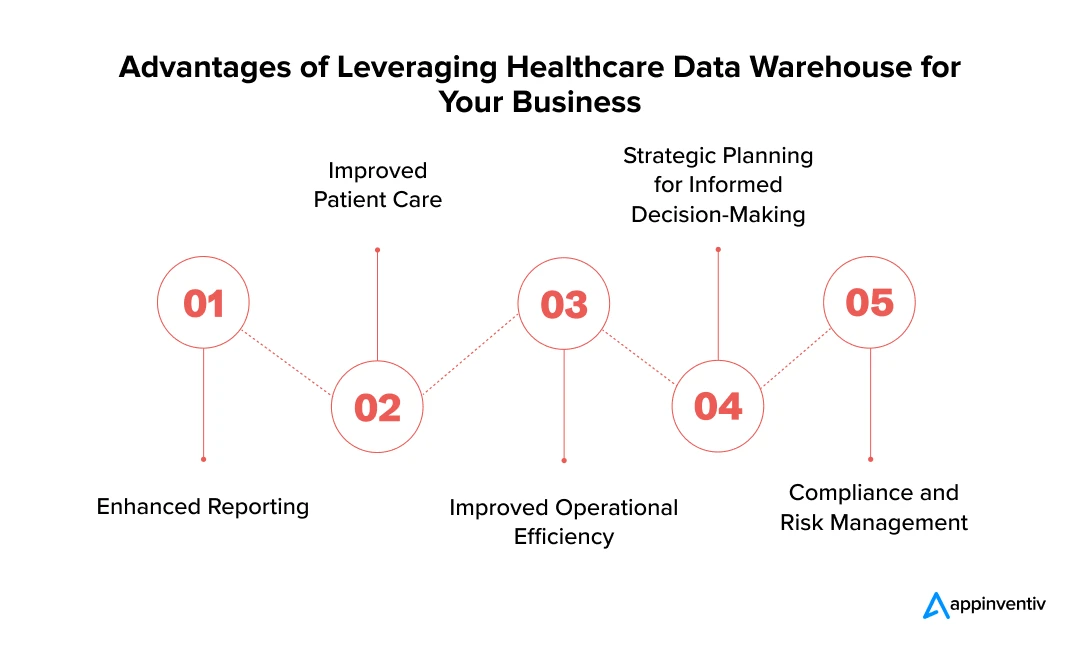
Enhanced reporting: Using data warehouses significantly enhances organizational efficiency and reduces the time needed to create reports. It also offers a unified data view that supports informed analysis and decision-making based on a comprehensive dataset.
Improved patient care: Using insights from detailed data analytics, healthcare providers can catalyze medical workflow. This enhances patient care and drives cost-effectiveness.
Improved operational efficiency: With insights backed by solid data, medical organizations can improve resource allocation, streamline operational workflow, and amplify staff productivity. This, in turn, helps reduce additional costs and strengthen overall operational efficiency.
Strategic planning for informed decision-making: Leveraging advanced analytical tools and predictive modeling helps medical organizations make strategically informed decisions. It also allows them to plan for the future.
Compliance and risk management: Robust encryption of data, data management processes, and compliance mechanisms help protect sensitive patient information. It mitigates the risk of data breaches, financial penalties, and regulatory non-compliance.
[Also Read: A Complete Guide to Healthcare Compliances]
Enhanced patient care: Data-driven decisions help healthcare workers provide personalized care, creating a better patient experience. This helps foster patient loyalty, satisfaction, and retention.
[Also Read: Benefits of Warehouse Management System Development: All You Need to Know]
Key Features to Locate When Implementing a Healthcare Data Warehouse
Creating an effective and efficient healthcare data warehouse involves more than just analyzing huge volumes of data. It demands a strategic approach to design and functionality that focuses on specific needs of patient care optimization, healthcare analytics, and operational efficiency.
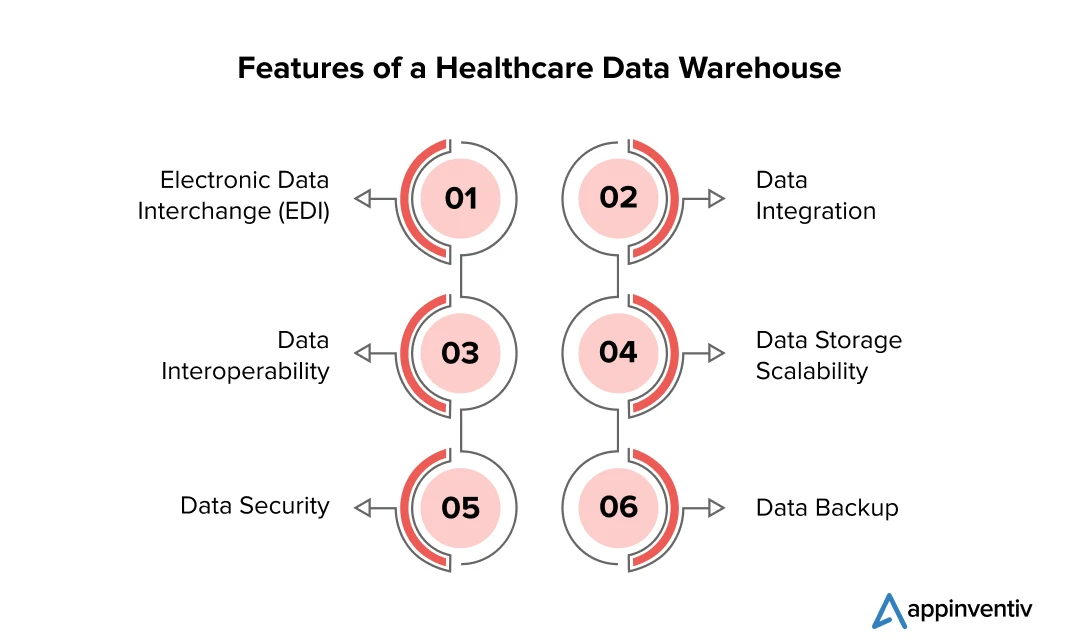
Here are the main healthcare data warehouse features that you must look for to meet the complex demands of the medical industry.
Electronic Data Interchange (EDI)
Data can be seamlessly exchanged using EDI among different healthcare systems. It helps streamline processes such as patient records management, supply chain operations, and patient billing.
Data integration
The overwhelming volume and complexity of medical data generated from various resources can present significant challenges. Efficient management of this information requires advanced storage solutions and data management strategies.
Incorporating business intelligence tools and machine learning software provides a structured view of the information. This allows healthcare providers to gain insights into a patient’s health status, leading to proactive health management, personalized treatment, and improved outcomes.
Data interoperability
Your healthcare data warehouse should be able to accurately interpret data exchanged between different systems. Insufficiency in interoperability can cause increased medical errors, delays in care, and increased medical costs.
The healthcare interoperability solution market is estimated to grow at a rate of 14.27% between 2023 and 2028. This highlights the need for technologies that enable efficient sharing and use of data.
[Also Read: Achieving Interoperability in Healthcare IT – The Whys and Hows]
Data storage scalability
The digitalization of medical records is leading to an exponential increase in data volume. The healthcare data warehouse for medical care should meet these growing demands without compromising reliability or performance.
Data Security
Healthcare information is highly sensitive and requires top-notch storage security. According to hipaajournal.com, 5887 large healthcare data breaches have been reported between 2009 and 2023 at the Office of Civil Rights (OCR). Surprisingly, the most common reason for these breaches was unauthorized access.
Medical data has a long lifespan, often needing to be preserved for decades. Therefore, advanced security measures are mandatory to protect this sensitive data.
Data backup
The criticality of healthcare data necessitates robust data backup and disaster recovery plans. Healthcare data is multifaceted which makes it even more challenging to secure it. Medical storage systems should have a robust backup, allowing it to be recovered in the event of data loss.
A Brief Glance Into Data Warehousing Implementation
In order to grant healthcare providers a 360-degree insight into patient care and associated healthcare operations, data warehousing implementation is carefully approached. Here’s what the implementation steps can look like.
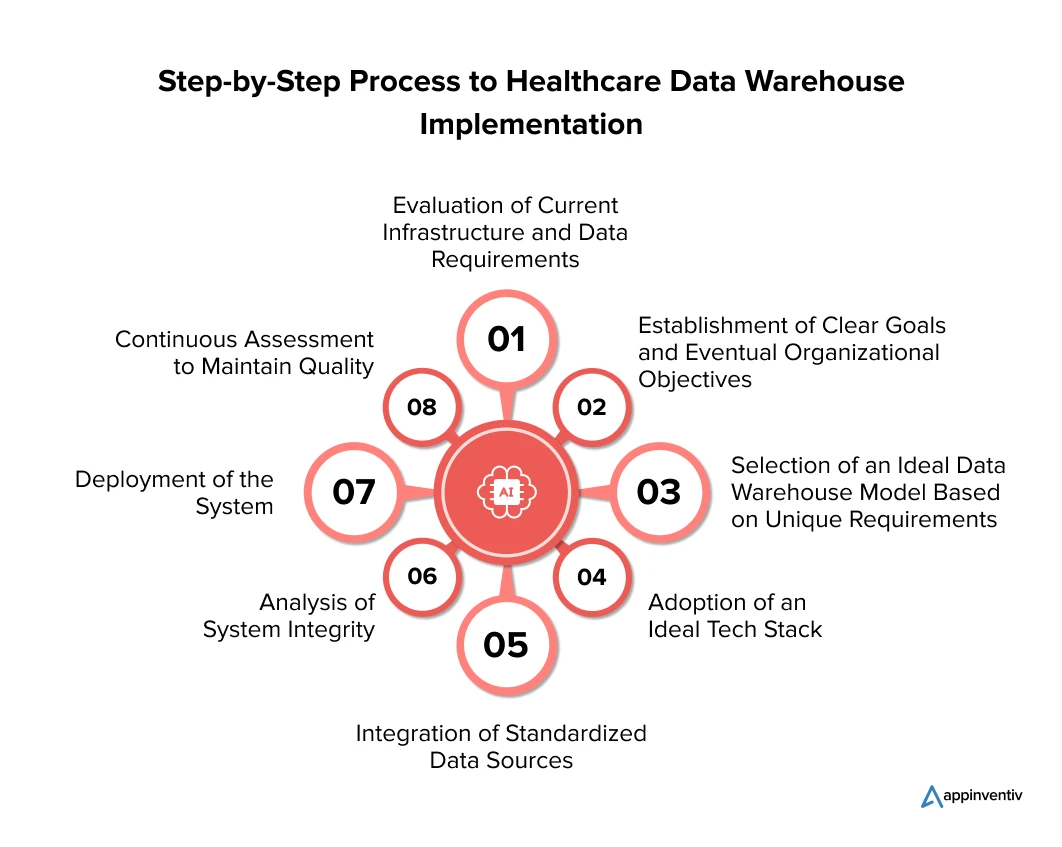
Evaluation of Current Infrastructure and Data Requirements
Assess the existing data systems and determine what types of data need to be included in the new data warehouse. This step ensures that the warehouse will integrate well with current technologies and meet specific data needs.
Establishment of Clear Goals and Organizational Objectives
Define what the organization aims to achieve with the data warehouse, such as improving patient outcomes or streamlining administrative processes. Clear goals guide the rest of the implementation process.
Selection of an Ideal Data Warehouse Model
Choose a data warehouse architecture that fits the organization’s specific requirements. This might involve deciding between a cloud-based or on-premises warehouse, depending on needs like security and scalability.
Adoption of an Ideal Tech Stack
Select the right technology tools and platforms that will run and support the data warehouse. This includes hardware for storage and software for Healthcare data analysis and management.
Integration of Standardized Data Sources
Bring together data from various sources and ensure it adheres to consistent formats and standards. This makes the data easier to analyze and use across different departments.
Analysis of System Integrity
Evaluate the data warehouse system to ensure it is secure and operates correctly, preventing data leaks and ensuring data accuracy.
Deployment of the System
Roll out the fully configured data warehouse so it can start to be used in daily operations. This phase includes training staff on how to use the new system effectively.
Continuous Assessment to Maintain Quality
Regularly check and update the data warehouse to address any issues, incorporate new data sources, and improve functionalities. This ensures the system remains reliable and valuable over time.
Healthcare Data Warehousing: Best Practices
Operating a clinical data warehouse in healthcare can surely help medical organizations boost their services and manage costs. To successfully operate data warehousing in healthcare, these are a few best practices that must be followed:
- Set targets to be fulfilled for each field – from streamlining operations to improving patient care.
- Ensure quality of data.
- Have strict protocols in place for data validation and cleansing.
- Select a suitable system for your present needs that is scalable.
- Implement strong security measures and focus on data safety.
- Ensure compliance with set regulations.
- Involve end-users in the process. Collect feedback to make the result more user-friendly.
- Provide proper training to employees, making the most of the software’s possibilities.
- Set aside resources for emergencies. Make ongoing maintenance, keeping the system at its best.
Challenges Tackled by Healthcare Data Warehousing
Data warehousing in healthcare helps tackle several challenges faced by healthcare organizations. This virtual tool assists healthcare professionals in delivering personalized patient care.
Let’s see the challenges that can be tackled by incorporating a data warehouse for healthcare data management strategy.
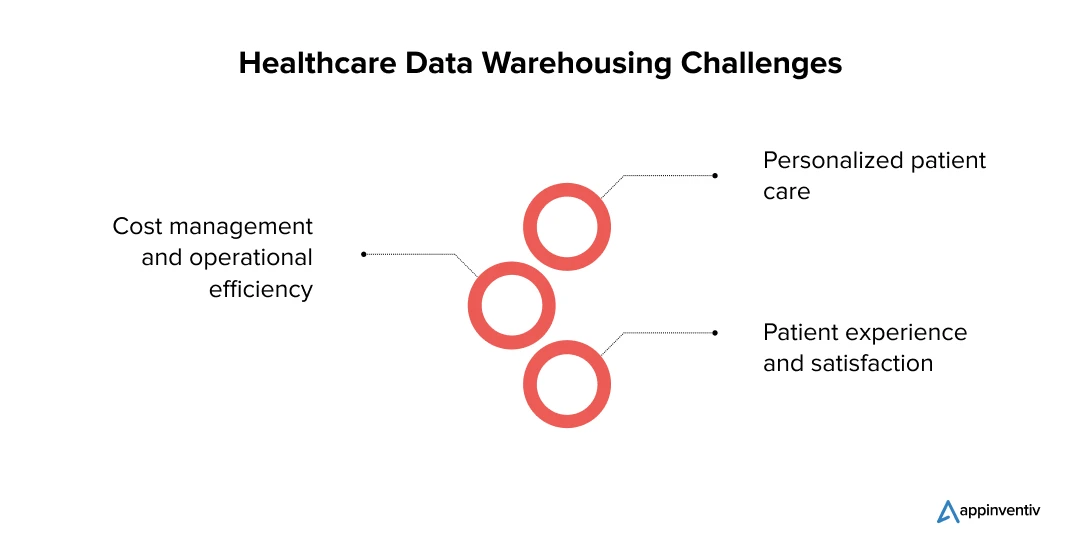
Challenge 1: Personalized patient care
Problem: A major challenge that medical institutions struggle with is disjointed patient data from multiple sources. This could include imaging systems, EHRs, lab tests, etc. In such cases, hospitals are unable to deliver individual personalized care.
Solution: Using a cloud data storage that combines patient data from several sources can help provide personalized patient treatment. The centralized data warehouse provides healthcare professionals with a thorough view of every patient’s medical history.
Strong ETL processes are used to gather information from multiple sources. Also, data integration services are used to merge and standardize data from disparate sources.
Challenge 2: Cost management and operational efficiency
Problem: Disjointed patient data makes it challenging to gain an overall view of operations. This leads to heightened operational costs.
Solution: A cloud data warehouse accumulates operational data from disparate sources. Analytical tools are used to generate insights and identify insufficiencies such as resource overstocking or underutilization. With these tools, medical workers can make data-driven decisions.
Challenge 3: Patient experience and satisfaction
Problem: Patient satisfaction is necessary as it helps boost reputation. However, it is challenging to achieve without a 360-degree view of the different patient interaction touchpoints. Healthcare workers need help understanding patient needs and preferences with disjointed systems.
Solution: A cloud data warehouse in healthcare consolidates all patient information, providing a unified view. This allows medical organizations to reach target engagement and personalize communication strategies. Patient engagement tools can also be used to personalize treatment based on insights derived from the data warehouse.
Bonus Read : The Ultimate Business Guide to Healthcare Application Development
Revolutionize Data-driven Patient Care with Appinventiv’s Healthcare IT Services
To develop a holistic data management strategy, it is imperative to have a data warehouse that ascertains data consistency and quality. A clinical data warehouse not only helps boost the performance of the healthcare organization but also assists in providing personalized treatment.
As a dedicated healthcare mobile app development company, we understand the critical role that data plays in healthcare. Our expertise in developing sophisticated data warehouses ensures that healthcare providers can rely on high-quality, consistent data to make informed decisions. By integrating advanced analytics and data management techniques, we help you navigate the complexities of modern healthcare environments.
Our team excels in creating customized healthcare solutions that streamline data processing and enhance patient care. Our expertise can be demonstrated in our highly-sophisticated projects in the healthcare sector which includes the likes of YouCOMM, Soniphi, and Health-e-People, reflecting our commitment to advanced technology.
Get in touch with our experts to learn how our deep industry knowledge and technical prowess can help you transform patient care in your organization.
FAQs
Q. What is data warehousing in healthcare?
A. Data warehousing in healthcare refers to the practice of collecting, organizing, and storing large amounts of health-related data from various sources in one central system. This allows healthcare professionals to use specialized tools to analyze the data, identify trends, and make informed decisions that improve patient care and operational efficiency.
The integration of this data also supports better resource management and enhances the quality of healthcare services by paving the way for more personalized treatment plans. In addition to this, it also helps in adherence to compliance with regulatory requirements by ensuring the data is securely managed and easily accessible when needed.
Q. Which warehouse is best suited for the healthcare sector?
A. The answer largely depends on the size of the organization. If you are a small organization, independent data marts are ideal for you. These smaller, more focused data storage facilities pave the way for quick access to specific subsets of data, making them cost-effective and efficient for managing smaller volumes of information.
However, for large healthcare organizations, enterprise data warehouses are particularly well-suited. They can handle vast amounts of data from multiple departments, integrating them into a single repository. This extensive integration supports complex analyses and makes way a deeper understanding of large-scale trends and patient outcomes across the entire organization.
Q. How much does it cost to develop a healthcare data warehouse?
A. The cost to develop a healthcare data warehouse can range from $40,000 to $300,000 or more. The final price depends on several factors, including the size of your organization, the complexity of the data, and the specific features you need.
In addition to this, the overall budget can also be impacted by the need for custom integrations with existing systems, the level of security required to protect sensitive health information, and ongoing maintenance and support services to keep the data warehouse running smoothly.



Healthcare IT Outsourcing: Key Benefits, Best Practices, and Implementation Process
Key Takeaways Reduce Costs by 30-40%: Convert capital IT expenses to predictable operational costs, eliminating the need for large in-house teams and infrastructure. Focus on Core Patient Care: Free up internal resources from IT management to concentrate on core healthcare services, innovation, and growth. Ensure Compliance & Mitigate Risk: Leverage expert partners to navigate HIPAA…
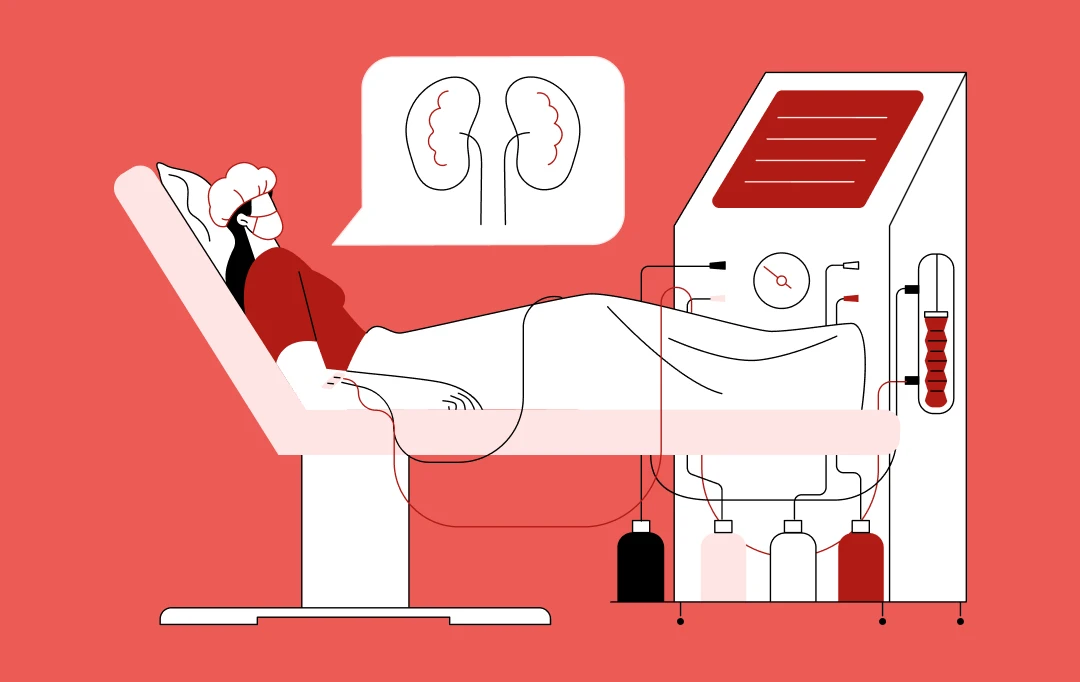
How AI-Powered Virtual Health Assistants Are Enhancing Remote Patient Monitoring
Key takeaways: Remote patient monitoring has the potential to reduce hospital readmissions by up to a quarter, shifting healthcare from reactive to proactive care through continuous, real-time health tracking. The U.S. health intelligent virtual assistant market is expected to reach $1.87 billion by 2030, driven by the growing demand for continuous care, virtual consultations, and…

Why Telehealth Security is Non-Negotiable for Patient Trust and How to Achieve It
Key takeaways: Telehealth security is crucial for patient trust and the continued adoption of digital healthcare services. The rising tide of cyber threats, from ransomware to inadequate authentication, poses significant risks to patient data and provider reputation. Implementing robust security measures like end-to-end encryption, multi-factor authentication, and regular audits is non-negotiable. Compliance with regulations like…



















